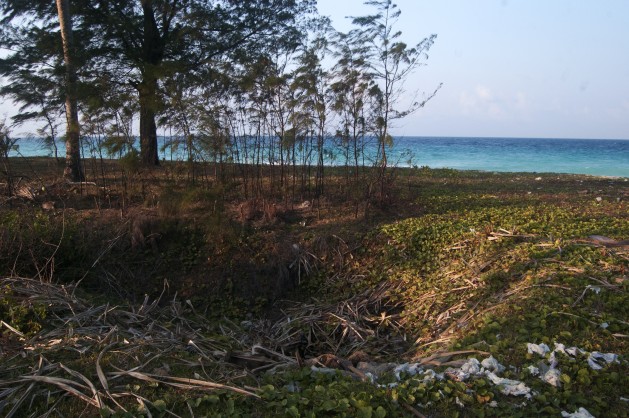
The administration in this popular tourist destination in the Bay of Bengal may be prepared for another tsunami. But it seems clueless about these holes in the ground that can sometimes cave in or lead to other geological events like hot springs, water spouts, natural gas emissions or even cracks in the subterranean magma chambers.
Islanders told IPS that sinkholes have appeared all over Nicobar. Whether that is also the case with the Andamans remains a matter of speculation as there is no official documentation of it, nor did the administration facilitate this writer's photo assignment to visit the geologically volatile islands.
IPS discovered and photographed sinkholes in three Nicobar Islands - Car Nicobar, Kamorta and Campbell Bay.
"Car Nicobar is full of sinkholes after the tsunami. Even though I grew up here, our parents are now petrified of us swimming near the beach," says Dr. Christina Rossetti, a local of Car Nicobar who works at a government-run hospital here.
Indian Air Force officers at Car Nicobar documented a water spout in April 2013 which shot up from a sinkhole to 1,000 metres in the sky over the Bay of Bengal.
Tsunami survivors in Car Nicobar also told IPS about water spouts that injured their eyes during the disaster.
Sinkholes can be either the cause or the consequence of quicksand, hot springs, geysers, natural gas emissions or water spouts. Initially the surface starts collapsing.
"Usually the depression goes on increasing in depth and it transits from depression to saucer to cup," Dr. Arun Bapat, formerly head of earthquake engineering research at the Central Water and Power Research Station in the western Indian city of Pune, told IPS.
"Sinkholes are usually formed in calcareous formation. The reduction or dissolution of calcium due to drainage or erosion or natural flow of water can cause sinkholes. Earthquakes are not the main cause of sinkholes. But it is possible that in calcareous rock, when a landslide has occurred during or immediately after earthquake, landslides could lead to sinkholes," says Bapat.
Sinkholes look deceptively benign, but anything from quicksand to natural gas could be hidden beneath, deceiving people and livestock who may innocently trample the surface and be swallowed into geysers or cavernous black holes in the ground.
Sinkholes, which range from a few centimetres to 600 metres in diameter, can appear in the aftermath of big seismic events.
Referring to Thailand, the 2005 United Nations Environment Programme report 'Rapid Assessment after Asian Tsunami' says: "Between the earthquake of 26 December 2004 and 24 January 2005, 25 sinkholes have been reported, an unprecedented frequency; 17 of them were reported in the six tsunami-affected provinces."
But no such assessment has been done for India's Andaman and Nicobar Islands.
IPS approached several authorities, including the National Geophysical Research Institute, the National Institute of Ocean Technology, the Indian National Centre for Ocean Information Services, the Geological Society of India, but drew a blank.
The secretary of the Disaster Management Authority for Andaman and Nicobar Islands (DMA) was on leave and the director of DMA did not answer calls.
Sakshi Mittal, deputy commissioner of Nicobar, said, "This has not been brought to my notice yet." Lt. Gen. A.K. Singh, Lieutenant-Governor of Andaman and Nicobar, the highest ranking official of the island territory, told IPS, "We have no idea about sinkholes, please complete your research and inform us."
This administration seems unaware of potential dangers even though the area is home to 350,000 people, 20,000 of whom are highly endangered indigenous people. Its picturesque locales drew 250,445 tourists in 2013.
Ambikaprasad Mallik, a scuba diving instructor in Havelock Island, told IPS, "If a series of sinkholes on the beach collapses at one go, the difference of levels in the water and land masses can create waves and even cause a small local tsunami."
Sinkholes occur in many parts of India and the world. They have accounted for the disappearance of human beings, livestock, rivers, buildings and vehicles.
"Sinkholes represent a hazard to property and human safety in a wide variety of geologic settings across the globe," says the USGS on one of its websites.
Florida in the US is particularly prone to sinkholes, with one last year swallowing a 37-year-old man in his sleep. Another engulfed a forest in Louisiana.
Geologists fight shy of forecasting the precise cause and consequence of sinkholes.
Prof. Kusala Rajendran of the Centre for Earth Sciences at the Indian Institute of Science in Bangalore told IPS, "It is unlikely to lead to anything life threatening, but there may be signatures of deformation such as fissures. This might depend on the region. During seismic activity, land can go down soon after the earthquake. Sinkholes form much later. They develop gradually and are well expressed."
Comment: Sorry to disturb your little nap there Professor, but people, whole families, animals, and heaps of vehicles have recently been swallowed whole by unannounced sinkholes. Nothing gradual about them for the unsuspecting surface dwellers.
Bapat says, "The sinkholes recently formed in Andaman and Nicobar are probably due to the tsunami. Sometimes, due to geological formation and geometry in the coastal area, stationary waves are formed and this keeps the water vibrating in vertical direction."
USGS notes: "Sinkholes are dramatic because the land usually stays intact for a period of time until the underground spaces just get too big. In most cases, the subsidence rate of a sinkhole represents the most significant potential impact and risk to public safety."
Sinkholes on volcanic slopes like Krakatau in the Java Straits have triggered minor earthquakes. Barren Island, South Asia's only active volcano located in the Andamans, has been spewing lava since January 2010.
With no public transport available to Barren Island, this writer's request to the island administration to facilitate a photo shoot there and in other parts of Andaman district where mud volcanoes are expanding was not accepted.
Inter Press Service



Comment: The total of sinkholes for this year is already approaching the tally for 2013, as can be seen below.